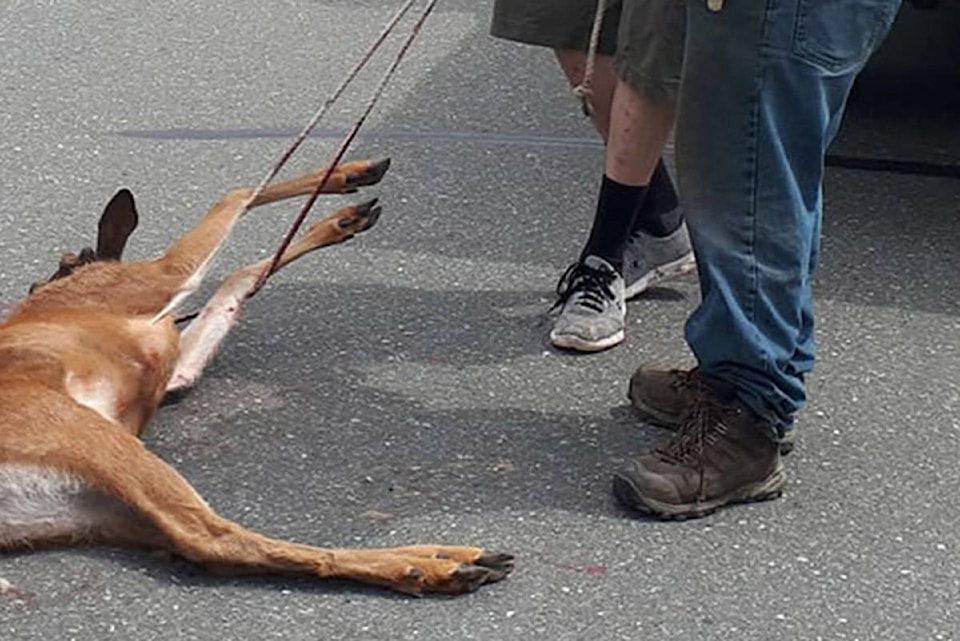Conflicting accounts have emerged about the fate of a wounded deer on the Old Island Highway near Campbell River.
A woman has claimed that a highway worker participated in the alleged beheading of the injured animal, an act that she called cruel and unnecessary.
But an official from Emcon, the road maintenance firm, has said that highway workers weren’t involved in the killing of the animal, and that the supposed decapitation never occurred.
The alleged incident came to light after a Campbell River woman driving along the Old Island Highway near Jubilee Parkway stopped to intervene and take photos. Snapping those photos resulted in a roadside confrontation, with one man allegedly chasing her away from the scene.
Crystal Martin said the deer, which had been struck by a vehicle, was standing and walking around when she arrived on the scene on the afternoon of June 6.
Two men then allegedly forced the animal to the ground, restraining it with rope, before they beheaded it using what Martin described as a hacksaw, supplied by a highway worker who arrived on the scene shortly after Martin.
She said that when she tried to intervene and take photos of the incident with her cellphone, one of the men allegedly chased her away, trying to grab her and take her phone before she fled to her car.
Martin, who studies human resource management, reported the incident to police but said “they didn’t acknowledge” what she called an assault against her.
As for the alleged cruelty towards the animal, she said police referred her to the BC Conservation Office in Courtenay. In a Facebook post, she called for other witnesses to come forward.
The Campbell River RCMP media contact didn’t return a request for comment on Friday, but CTV News quoted Campbell River RCMP Cpl. Ron Vlooswyk as stating that no criminal offence occurred, adding that police received no word of threats towards Martin.
A highway worker provided a very different version of events, according to Stewart Westwood, an operations manager for Emcon Services, the highway maintenance firm responsible for roads in the North Island area.
Westwood, who interviewed a highway worker after the incident took place, said an Emcon employee went to retrieve the carcass of a struck animal, only to find that it was still alive.
“When the operator got out, it jumped up,” he said.
The company’s usual protocol is to contact the RCMP or conservation officers when a wounded animal isn’t dead, but members of the public decided to “put it out of its misery,” he said. The men didn’t behead the animal, he said, but slit its throat.
According to Westwood said his employee described a woman taking pictures before being asked to stop by the man putting the deer down. When she persisted, the man said he wanted the photos deleted.
“They exchanged words and he went to her car,” said Westwood. “That’s all I know.”
The deer’s carcass was then removed in an Emcon truck, he said, noting that highway workers “had nothing to do with how they killed the deer.”
The removal of roadkill is a daily occurrence for the company, he added. The firm receives at least one call daily for the removal of struck animals in the North Island service area – which stretches from Cook Creek to Port Hardy – but highway workers sometimes deal with up to 20 animals in a day, said Westwood.
The BC Conservation Service said in a statement that members of the public who accidentally injure wildlife – whether by vehicle or otherwise – should reach out to the Report All Poachers and Polluters (RAPP) hotline.
People trying to help animals on the road could get hit by a passing car, or the animal could end up in the roadway, leading to further injuries to the animal or to another member of the public, according to the statement.
The statement also noted that although conservation officers may need to euthanize injured animals, “this is always done in the most humane manner possible” and that members of the general public “should not attempt to do this themselves.”
